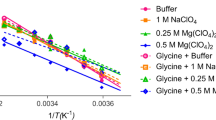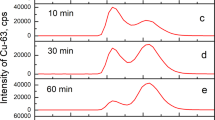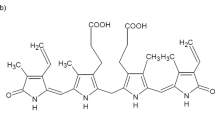Abstract
ON addition of a small amount of phenyl hydroxylamine (C6H5.NHOH) to a fresh alkaline solution of hæmatin prepared from hæmin crystals, the colour of the solution turns rapidly from brown to bright red and its absorption band at about 630 mµ is replaced by two strong but somewhat diffuse bands at 562 mµ and 532 mµ. Two molecules of phenyl hydroxylamine per molecule of hæmatin are required for the complete formation of this new compound. Its instantaneous formation suggests in the first instance the view that in this reaction hæmatin combines directly with the phenyl hydroxylamine in the same way that it does with a variety of other nitrogenous substances. This view was not, however, supported by further experiments, which can be summarized as follows :
This is a preview of subscription content, access via your institution
Access options
Subscribe to this journal
Receive 51 print issues and online access
$199.00 per year
only $3.90 per issue
Buy this article
- Purchase on Springer Link
- Instant access to full article PDF
Prices may be subject to local taxes which are calculated during checkout
Similar content being viewed by others
References
Jung, F., Naturwiss., 28, 264 (1940).
Warburg, O., Kubowitz, T., and Christian, W., Biochem. Z., 242, 170 (1931).
Author information
Authors and Affiliations
Rights and permissions
About this article
Cite this article
KEILIN, D., HARTREE, E. Reactions of Hæmoglobin and its Derivatives with Phenyl Hydroxylamine and Nitrosobenzene. Nature 151, 390–391 (1943). https://doi.org/10.1038/151390a0
Issue Date:
DOI: https://doi.org/10.1038/151390a0
This article is cited by
-
Die Bindung von Nitrosobenzolderivaten an menschliches H�moglobin
Die Naturwissenschaften (1960)
-
Oxidation of Phenyl-Hydrazines in the Presence of Oxyhæmoglobin and the Origin of Heinz Bodies in Erythrocytes
Nature (1954)
-
Position of Hæms in the Hæmoglobin Molecule
Nature (1953)
-
Hæmoglobin in Fungi: Occurrence of Hæmoglobin in Yeast and the Supposed Stabilization of the Oxygenated Cytochrome Oxidase
Nature (1953)
Comments
By submitting a comment you agree to abide by our Terms and Community Guidelines. If you find something abusive or that does not comply with our terms or guidelines please flag it as inappropriate.



